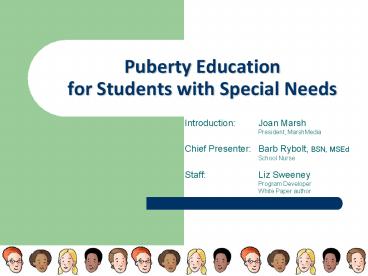Puberty Education for Students with Special Needs - PowerPoint PPT Presentation
1 / 25
Title:
Puberty Education for Students with Special Needs
Description:
Communicate the importance of good nutrition and exercise. Chapter 3: Staying Healthy ... Maintaining good health through diet and exercise can help with some of the ... – PowerPoint PPT presentation
Number of Views:958
Avg rating:3.0/5.0
Title: Puberty Education for Students with Special Needs
1
Puberty Education for Students with Special Needs
- Introduction Joan Marsh
- President, MarshMedia
- Chief Presenter Barb Rybolt, BSN, MSEd
- School Nurse
- Staff Liz Sweeney
- Program Developer
- White Paper author
2
Agenda
- Introductions and Icebreaker
- Goals and Objectives of the Presentation
- Overview of the Girls/Boys Guides to Growing
Up - Chapter 1 Your Body
- Chapter 2 Change is On the Way
- Chapter 3 Staying Healthy
- Chapter 4 Keeping Clean
- Chapter 5 Privacy and Safety
- Fortune Favors the Brave!
- Question period
3
Goals and Objectives
- The purpose of puberty education for students
with special needs. - Adapting strategies and materials to make
learning developmentally appropriate. - Steps to implementation.
4
The purpose of puberty education for students
with special needs
- Like all children, students with developmental
disabilities grow into adolescence with
physically maturing bodies and a host of emerging
social and sexual feelings and needs. Before
these changes begin and throughout adolescence,
it is important that educators and parents
provide factual information in a positive and
constructive way that is both clear and
developmentally appropriate.
5
Adapting strategies and materials
- There are three important educational
considerations - Is the language and vocabulary for instruction
simple and clear? Can it be reinforced in a team
approach? - Are concepts presented in the most concrete ways
possible? - Are there opportunities for repetition, practice
and application?
6
Steps to implementation
- Engage teachers, administrators, parents or other
key personnel in the process. - Design an outline and schedule of sessions.
- Facilitate learning sessions.
7
Overview of the Girls/Boys Guides to Growing
Up
- Components of the kit include
- Teaching guide
- Student booklets
- DVD or video
- New parent handbooks are available as supplements
to serve in the home setting.
8
Chapter 1 Your Body
- Instructional Goals
- Introduce male/female anatomy.
- Distinguish between private and other parts of
the body. - Give names to the private parts.
- Give functions to the private parts.
9
Chapter 1 Your Body
- Considerations
- Teach vocabulary labeling and describing.
- Acknowledge different labeling words but teach
correct biological labels. - Help students become aware of appropriate
settings for discussions about puberty or private
parts.
10
Chapter 1 Your Body
- head
- arms
- nipples
- breasts
- back
- pubic area
- rectum
- legs
- feet
11
Chapter 2 Change is On the Way - Boys
- Instructional Goals
- Describe the physical changes that happen to the
body during puberty. - Explain that other changes such as pimples and
increased sweating may occur, and how to cope
with these changes. - Explain what a wet dream is and that it is
normal. - Reassure students that puberty happens to
everyone.
12
Chapter 2 Change is On the Way
- Considerations
- Maintain a positive attitude. Change can cause
anxiety. Straightforward information can relieve
embarrassment. - Be precise and break concepts into steps where
necessary. - Discuss good advisors. Other children are usually
not the best source for information.
13
Chapter 2 Change is On the Way - BoysSpot
the Difference
14
Chapter 2 Change is On the Way - GirlsI Know
What to Do
- When I I would
15
Chapter 3 Staying Healthy
- Instructional Goals
- Prepare students for changes in mood.
- Provide advice on talking about feelings.
- Communicate the importance of good nutrition and
exercise.
16
Chapter 3 Staying Healthy
- Considerations
- Puberty can be a confusing time. It is important
to prepare students to identify and manage a
variety of emotions. - Maintaining good health through diet and exercise
can help with some of the emotional and physical
strains of adolescence. Sleep and rest are also
important.
17
Chapter 3 Staying Healthy
18
Chapter 4 Keeping Clean
- Instructional Goals
- Communicate the importance of handwashing.
- Promote a hygiene routine.
- Prepare students for managing sweat and pimples.
19
Chapter 4 Keeping Clean
- Considerations
- Many students will already be aware and
self-sufficient in the area of personal hygiene.
Others will need specific advice and how-to
instruction, as well as practice and
reinforcement.
20
Chapter 4 Keeping Clean
21
Chapter 5 Privacy and Safety
- Instructional Goals
- Distinguish between private and public places.
- Explain behavior appropriate to each place.
- Stress the importance of respecting other
peoples privacy. - Help develop an awareness of when the behavior of
others is inappropriate.
22
Chapter 5 Privacy and Safety
- Considerations
- Children with special needs are at higher risk
for sexual abuse than their peers. - Teachers are required to report suspected child
abuse. - Role-playing is a helpful strategy for teaching
about sexual abuse.
23
Chapter 5 Privacy and Safety
- Role Play
- Being introduced to someone new.
- Greeting a friend.
- Seeing someone change clothes in the locker room.
- Being told to keep a secret about something that
makes you feel uncomfortable.
24
Fortune Favors the Brave!
- Instructional reminder
- Is the language and vocabulary for instruction
simple and clear? Can it be reinforced in a team
approach? - Are concepts presented in the most concrete ways
possible? - Are there opportunities for repetition, practice
and application?
25
Questions
- QA

